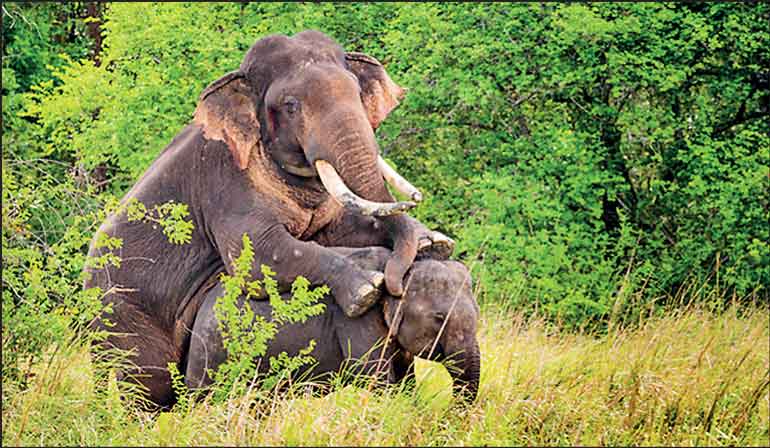Thursday Oct 02, 2025
Thursday Oct 02, 2025
Friday, 8 August 2025 00:20 - - {{hitsCtrl.values.hits}}

 Sri Lanka’s last wild tuskers — majestic, rare, and silently disappearing — are on the brink of vanishing forever. These giants once roamed in strength and abundance across the island, but now, only a handful remain in the wild. Their disappearance is not only a visual and cultural loss — it marks the impending extinction of the tusk gene from Sri Lanka’s wild elephant population. If that happens, it will be an irreversible blow to the nation’s biodiversity.
Sri Lanka’s last wild tuskers — majestic, rare, and silently disappearing — are on the brink of vanishing forever. These giants once roamed in strength and abundance across the island, but now, only a handful remain in the wild. Their disappearance is not only a visual and cultural loss — it marks the impending extinction of the tusk gene from Sri Lanka’s wild elephant population. If that happens, it will be an irreversible blow to the nation’s biodiversity.
Current data shows that fewer than 7–8% of wild male elephants in Sri Lanka have tusks, a drastic decline when compared to other Asian elephant populations such as those in India or Sumatra, where tusks are still common among mature bulls. In our case, centuries of human activity — including selective hunting, capture, ivory trade, and habitat restriction — have driven tuskers to near-extinction. Today, the few that remain are genetic outliers, and without focused protection, their legacy may soon be lost.
A genetic crisis in the making
Tusked elephants are not merely beautiful; they are biologically vital. The presence of tusks in Asian elephants is governed by a dominant autosomal gene, meaning it can be inherited from either the mother or the father. Unlike African elephants — where female tusklessness is tied to an X-linked gene — in Sri Lankan elephants, both males and females can carry and pass on the tusk gene.
There is, however, a widespread misconception that tusks are inherited only from the mother — likely influenced by research on African elephants. In Sri Lanka, this is scientifically inaccurate and dangerously misleading. Since the gene can come from either parent, each remaining tusker is essential for preserving the genetic possibility of tusk-bearing elephants in the future.
With such a low population of tuskers in the wild, losing even one individual can have lasting consequences. Elephant populations reproduce slowly, with long gestation periods and few calves. If the tusk gene disappears from the breeding pool, it cannot be recovered — even with breeding programs or advanced reproductive technology. The loss would be permanent and absolute.
Tuskers in a changing landscape
Historically, tuskers were selectively targeted. During pre-colonial and colonial eras, large bulls with prominent tusks were hunted for sport and ivory. Later, many were captured for use in labour or ceremonial display, particularly during religious or royal events. This biased extraction not only reduced tusker numbers but also removed their genetic contribution to future wild generations.
Even after hunting was banned, tuskers continued to face threats. Poaching — though less prevalent than in African countries — still occurs. Human-elephant conflict continues to escalate as wild habitats shrink and fragment. Elephants — especially large, solitary males — are often killed or injured in retaliation when they enter farms or settlements in search of food or water. Tuskers, with their distinct appearance, are easy targets.
Furthermore, the ethical debate surrounding the continued use of tuskers in captivity and public parades — especially in hot, crowded urban settings — has become increasingly controversial. While some view these practices as traditional, conservationists and veterinarians warn that they remove vital genetic stock from the wild and expose individual elephants to significant stress, injury, and shortened lifespans.
Protecting tuskers should mean protecting their right to remain in the wild, as part of a functioning ecosystem — not removing them to perform symbolic roles that may no longer align with modern conservation ethics.
Ecological significance of tuskers
Tuskers play essential roles in elephant society and ecosystems. Mature bulls often become dominant breeders, contributing significantly to the gene pool. Their presence helps maintain a diverse and healthy population structure, reducing the risks of inbreeding and social instability. Beyond reproduction, tusks serve important functions in the wild: they are used to dig for water, strip bark, break branches, and defend against predators or rivals. These behaviours benefit the broader ecosystem — aiding in seed dispersal, forest regeneration, and landscape modification that supports other species. The extinction of tusked elephants would have cascading ecological impacts, subtly but profoundly reshaping Sri Lanka’s natural environment.
A national responsibility
Sri Lanka’s elephants are a distinct and globally recognised subspecies — ‘Elephas maximus maximus’ — found nowhere else in the world. They are listed as Endangered on the IUCN Red List, with populations under intense pressure from habitat loss, fragmentation, and conflict.
The extinction of wild tuskers would not only reduce the genetic richness of our elephants — it would permanently alter the character of our wildlife. This is not just a loss to conservation; it is a loss to national identity and global biodiversity. As stewards of a species unique to our island, we have a duty to ensure its full biological legacy survives.
What needs to be done — urgently
Sri Lanka must act decisively and scientifically to ensure the survival of wild tuskers. The following policy actions are essential:
Recognise tuskers as genetically significant individuals under national wildlife law. This could involve a separate status within the elephant population management framework, with strict penalties for harm, harassment, or unauthorised removal.
Use GPS collars, drone surveillance, and remote camera networks to monitor the movement and safety of tuskers across key ecosystems — including kahalla pallekele, Somawathiya, Wasgamuwa, Minneriya-Kaudulla, Uda Walawe, Gal Oya, and Yala, Kumana, Wilpattu, etc.
Restrict the removal of tuskers from the wild for festivals, parades, or private possession. This includes a clear ban on capturing wild tuskers for display purposes, regardless of tradition. Any existing captive tuskers should be managed with strong welfare oversight and must not be replaced by new captures.
Enhance ranger presence in elephant corridors, improve detection technology, and coordinate with law enforcement to dismantle ivory trade networks. Even isolated poaching incidents can be devastating given the low tusker numbers.
Ensure connectivity between key habitats to allow tuskers to move freely and mate. Isolated individuals cannot contribute to the gene pool. Corridor restoration must be prioritised under national land-use and conservation planning.
Inform the public — especially in rural areas — about the value of tuskers not just as charismatic animals but as genetic lifelines for future generations. Promote coexistence strategies and non-lethal conflict mitigation tools.
A defining choice for a generation
The survival of wild tuskers in Sri Lanka is at a crossroads. Our response now will define how future generations remember them — as living beings or as lost legends. Do we want our children to witness the soft thunder of a tusker’s footsteps through the forest? Or to see them only in photos, statues, and museum dioramas?
Tuskers are not just elephants with ivory. They are biological treasures, ecological engineers, and the last bearers of a dwindling gene that took millions of years to evolve.
If we fail them now, the loss will echo far beyond conservation reports. It will mark the end of a chapter in Sri Lanka’s natural history — one that should never have been allowed to close.
Let us act before it is too late. Not for tradition. Not for pride. But for the future — of our elephants, our ecosystems, and our island.
Conclusion: A call for leadership — not kneejerk reactions
At this critical juncture, Sri Lanka must confront an uncomfortable reality: we have never had a comprehensive, science-based masterplan for the long-term conservation and management of wild elephants. Since the establishment of the Department of Wildlife Conservation, efforts have remained fragmented, reactionary, and largely shaped by short-term crises and public pressure — not by evidence, ecology, or sustainability.
The much-discussed National Action Plan on Human-Elephant Conflict (HEC), developed under the terms of reference issued to the Presidential Commission (with due respect to the scientists who served on it — this is not a reflection of their intent or expertise, but of the mandate they were given), is emblematic of Sri Lanka’s broader failure in elephant conservation.
The plan focuses almost exclusively on protecting humans from elephants, rather than protecting elephants from extinction. It frames wild elephants — including the critically important and rapidly vanishing tuskers — not as a national treasure to be safeguarded, but as a problem to be controlled, fenced off, or removed.
This flawed framing ignores the root causes of elephant population decline — including habitat loss, genetic isolation, and the absence of proactive breeding and corridor protection strategies. As a result, it risks deepening the crisis rather than resolving it. A narrow, defensive approach to coexistence cannot ensure the survival of a species on the edge. What we need instead is a bold national vision grounded in science, ecology, and long-term responsibility.
What the country urgently needs is not another reactionary committee or symbolic policy — but a bold, cohesive, science-based Masterplan for Wild Elephant Conservation and Management. A national roadmap that:
To achieve this, we call on all stakeholders — government ministries, wildlife authorities, conservation scientists, civil society, and the media — to rise above political noise, emotional rhetoric, and institutional paralysis.
Let us move past reactive firefighting. Let us reject the temptation of oversimplified solutions. And above all, let us refuse to allow another generation of elephants — and tuskers — to disappear on our watch.
The wild tuskers of Sri Lanka are not just animals. They are biological keystones, ecological architects, and irreplaceable strands in the fabric of our island’s natural heritage.
If we fail to protect them with intelligence, foresight, and integrity — we will not only lose a species trait.
We will lose the opportunity to prove ourselves as responsible custodians of a living world that depends on us more than ever.
Now is the time for leadership — not excuses, not delays, and certainly not kneejerk reactions!